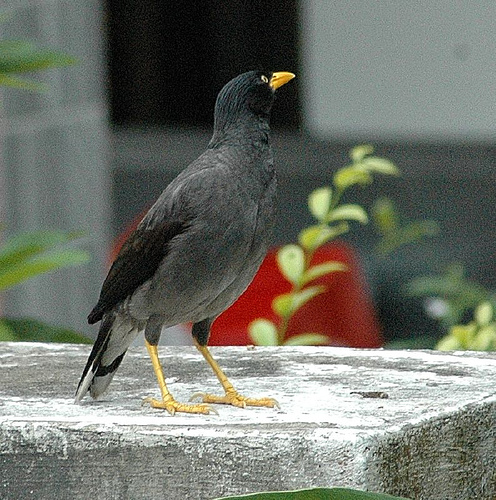- Javan Myna
Taxobox
name = Javan Myna
status = DD | status_system = IUCN3.1

image_width = 200px
image_caption = "Acridotheres javanicus"
regnum =Animal ia
phylum = Chordata
classis = Aves
ordo =Passeriformes
familia =Sturnidae
genus = "Acridotheres "
species = "A. javanicus"
binomial = "Acridotheres javanicus"
binomial_authority = (Cabanis, 1850)The Javan Myna ("Acridotheres javanicus"), also known as the "white-vented myna" and the "buffalo myna", is a
myna , a member of theStarling family.It is a successful species in much of South East Asia and has penetrated into India and neighbouring regions.
It is conspecific, and thought to be in competition with the Common or
Indian Myna ("A. tristis") in some of its range (for example,India ,Malaysia andSingapore ).The Javan Myna has an extremely liquid voice and, like the European starling, incorporates imitation into its repertoire (though it is not able to imitate the human voice, like the
hill myna "Gracula religiosa").The Javan myna is predominantly black, with a white vent, a white wing patch, white on the underside of the tail, and has a thick yellow eye ring, legs and beak. It sometimes has grey (white) flecking on its belly. It can raise the feathers on its forehead into a dramatic crest.
Like other Sturnids it is omnivorous, roosts in colonies and is abundantly successful in a variety of habitats. Javan mynas are as accomplished in cities as they are in padi fields, where they will prey on insects disturbed by water buffalo, often riding the buffalo like the related
oxpecker .The Javan Myna is considered a pest, especially in urban areas which they prefer. They deposit droppings over buildings and even on unsuspecting human beings. Their roost also contaminate the ground below by the droppings. Apart from that, they are also a source of noise pollution and are capable of spreading
zoonoses . In Singapore, the Javan Myna is one of the species of birds which can be killed by citizens without breaching of law.They are also available at most Singapore bird shops at a very cheap cost, thus, many of them are bought and release into the wild and damaging the ecosystem of Singapore even further.
There is some confusion over naming between "A. grandis" and "A. javanicus", which was until recently considered a
subspecies of the Pale-bellied Myna, "A. cinereus".
Wikimedia Foundation. 2010.
